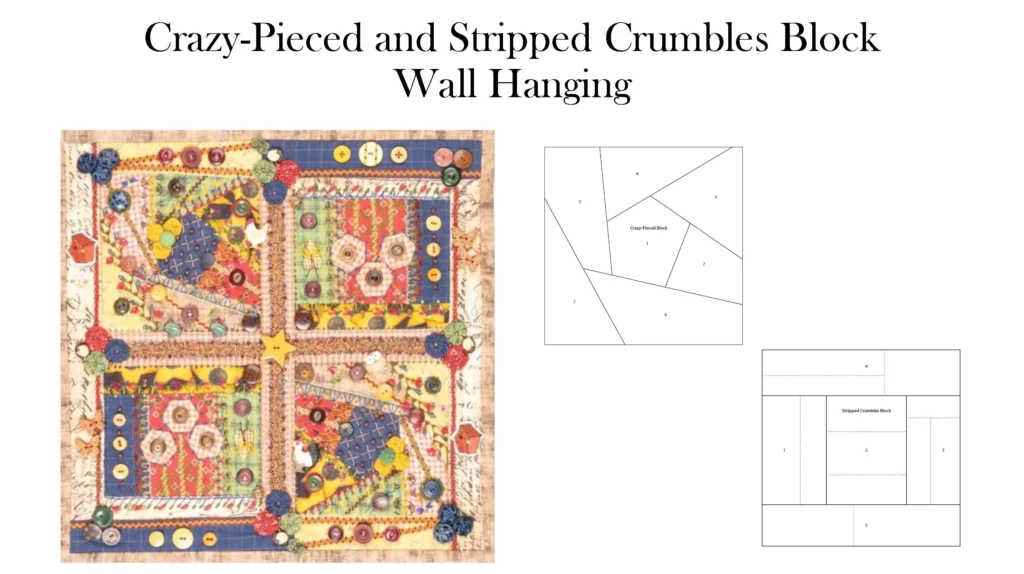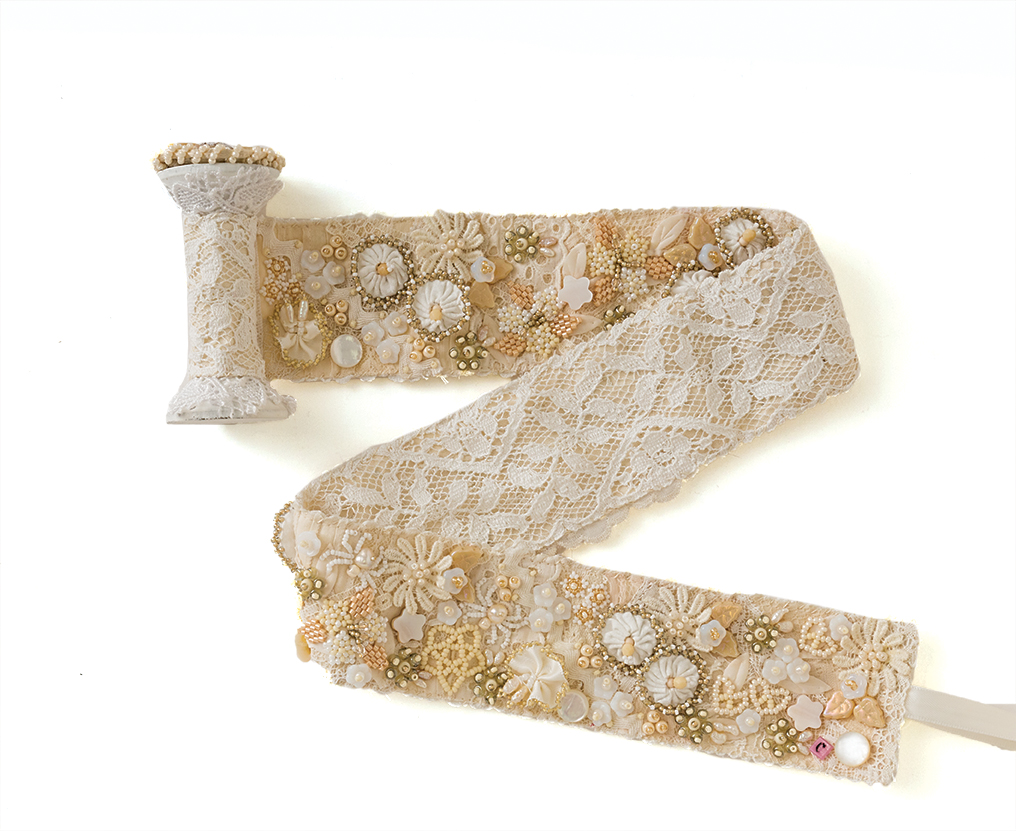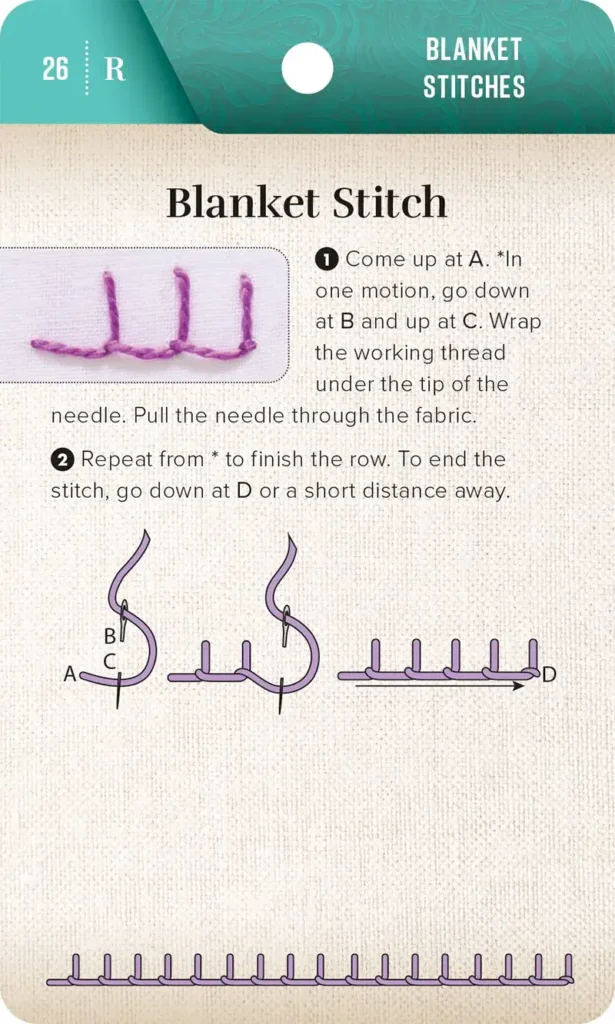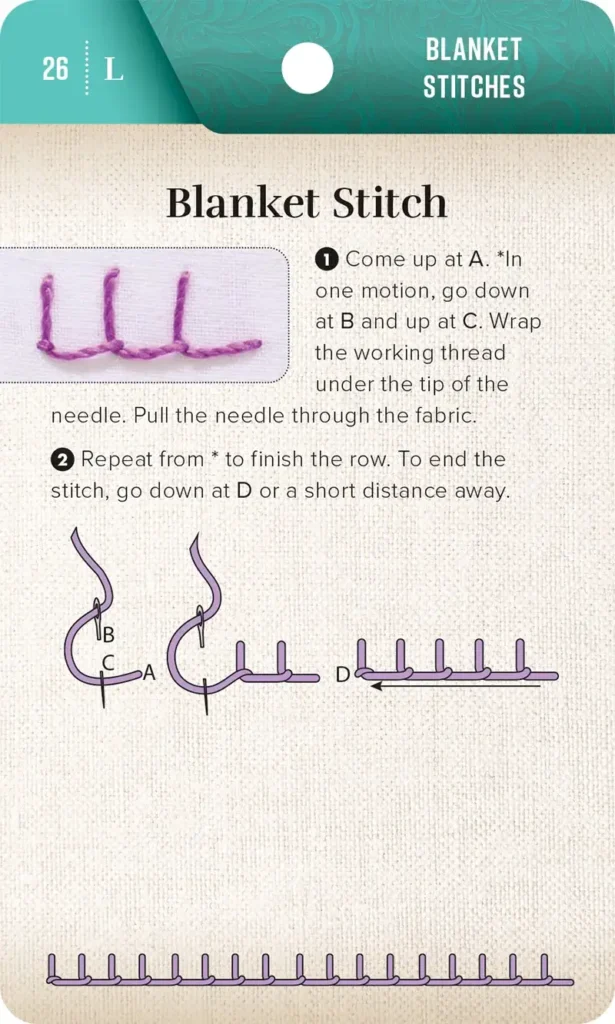With a needle in her hand since the age of 7, Christen Brown creates lush embroidered and beaded pieces to wear and admire. Generous with her knowledge, she shares her designs and techniques via workshops and a collection of books with detailed how-to instructions.

Why textiles? Why beading and embroidery? How did you get started?
Growing up in the 60’s was very different from today. Back then, my mom was a stay at home mom. She made most of our clothes on her little Singer portable sewing machine. She was self-taught and accomplished at many needle arts such as knitting, crochet, tatting and embroidery.
I learned how to embroider at the age of 7. It was the first needle art that I learned, and the one that I still practice every day. I have always loved jewelry, and in those days many of the necklaces were made from glass or plastic beads. Taking these apart, then repurposing them into my own jewelry and creations was as natural to me as working with a needle and thread.

What are your earliest memories involving your own creative expression?
As an Amazon Associate I earn from qualifying purchases. Read more about our affiliate linking policy.
Both of my parents had hobbies, so the leftover materials were there for my sister and me to work with. My dad was a proto-types engineer as well as a model airplane enthusiast. I loved the garage for the wood and metal smells. I would scavenge the bits and pieces wood, odd metal screws and nails, and then arrange the different shapes and textures in ephemeral mosaics on the garage floor.
In the spare room, my mom kept her fabric, threads, buttons and trims which were stashed in an old bookcase. I loved to play with the button box, because you would find all manner of treasures within. My mom’s best friend, my godmother, had all of her clothes handmade, and she would send us the leftover fabrics. I would fondle the precious bits of fabric remnants, imagining the fabulous garments that were just waiting to be made.

Do you have a dedicated space for creating? If so, what does it look like?
I have a room that is my space. I think that other people look at it as a chaotic grouping of this and that. But to me it is as if an organized tornado dropped all its treasure in neat piles around the room.

Do you have great bursts of creativity or does your creativity flow continuously?
There is always a project on my table. I work every day, anywhere from 2 to 10 or more hours, 7 days a week. However, my creativity explodes when I am in my most relaxed state of mind, no deadlines, no pressures, just in my room, happy, calm and quiet. There are not enough hours in the day, so let the adventure begin!

When you begin to create, do you visualize the finished piece? Or does the work evolve?
The beginning elements rest in a bag or a box until I think that I have enough materials to work with. Sometimes this process will take many years to find just the right items.
Every project begins with three components:
- Color: the most important for me
- Materials: fibers, trims, embellishments
- Composition: design and techniques
Once the first two criteria have been decided upon, I can begin the third element. Often, I work with finite amounts, so this will determine what the composition will be. While I create, I let the project evolve as I go – I set no boundaries. I may visualize how the base will begin, but I never presume I know what is right or what the outcome will be. Every project is exciting and offers me a chance to create something new.

How often do you start a new project?
I have a project on my work table every day, as well as several that are percolating on an adjacent table. When I am working on a project, I look at the colors and components of the next project, or next several projects. This helps me to visualize what the project will become, or the components that I need for the process to begin.
I don’t have room for my sewing machine to be up all the time, so when I piece a base for a project, I work on several bases at a time. I complete all of the handwork, the embroidery and embellishments for one base until it is completed and ready for backing and binding. Then I will work on several more projects and dedicate a day just for backing and binding those projects.

How many projects do you typically have in process at any given time?
My job, passion, calling, if you will, is not a 9-5 commitment. I work when the muse is awake, whether I am or not! So I usually have 3-5 (sometimes more) projects under development at any given time.
For me, the creative process of one piece does not always come together in one block of time. This might be due to the fact I am still gathering the right materials, or I have another project with a pending deadline, or I just am waiting for the inspiration to hit me.
Once I have all of my materials, I carve out a space of time to assemble the background piece. This means setting up the rotary cutter, mat, ironing board and sewing machine in my living room. My husband is retired, and we share that living space, so I try to get all that I can get done in one sitting. I do the remainder of the handwork – such as the quilting, embroidery and embellishing – in my dedicated workroom, which is set-up for me to work all hours of the day and night.

What inspired your newest book Beyond Crazy Quilts? What can readers expect?
Whenever I taught a class on crazy-piecing, I found that the students had a difficult time understanding how to determine the size of each section, and how to negotiate the negative spaces that needed to be filled.
I designed 6 new 6” blocks for this book, each with a unique design to help my readers and students with these issues. Three blocks are for strip, wedge, or crazy-pieced designs, and three blocks are for strip, wedge, or crazy crumbled designs.

There are 12 projects included in the book, which use one or more of the blocks. In addition the projects include small extras that can be added, creative piecing options, sashing, borders, and binding techniques.


Tell us more about your book, Creative Embroidery, Mixing the Old with the New, by C&T Publishing. What inspired you to write this book? What can readers expect?
The book all started with a lecture that I give titled “What’s in Your Button Box?”, where I talk about the types of buttons and materials that you may find. I thought that this would be an interesting premise for a book, and it should also include the other vintage items that you may have in your stash such as fabrics, hankies, table linens, doilies, laces, appliqués, trims, ribbons, threads, buttons, beads, notions, and more.
The chapter Altering the Past includes suggestions on how to take your smaller gathered bits and pieces to create something unique. The sections include Dyeing to be Beautiful, Ribbon and Trim Details, and Little Stitched Extras. The chapter Embroidery and Embellishment Stitches includes individual and grouped stitches, continuous stitches, flower and shape stitches, silk ribbon embroidery and ribbonwork stitches, and embellishments stitches. In the chapter Stitching Creatively, I include an Embroidery Sketchbook, which shows you how to combine these stitches into your work.

There are three Projects by Design, with step-by-step instructions, and 17 Stash Projects that have minimal instructions, so that you can adapt your own stash and ideas to the projects. There are also plenty of Stash Idea Inspiration pieces, including variations of the projects and other gallery examples.

How does your new Embellished Art Embroidery Project Planner work? Will it help both spontaneous fiber artists as well as those who prefer a more structured approach?
The planner is a tool to keep the creative mind sane. When I am working on a piece, I don’t always remember where the fabrics came from, or how long it took me to gather all of the components. I think of this as a way to document the journey each project takes from an “inkling” to completion.
The main portion of the book revolves around the 12 Project color wheel and 12-month Project Log. There are 4 pages dedicated for each of the 12 main projects. This is where you can list specifics like the title, purpose, date needed, materials, swatches, notes and drawings. Each stage of the creative progress is checked off, then recorded in the 12 Project color wheel overview.
I have also included a Small Projects log and a Works-in-Progress Log. It just makes sense to keep a record of all your creative aspirations in one handy planner. There are also blank pages throughout the book for you to jot down notes and Future Project Ideas.
For the structured artist, this journal allows you the time to get your creative projects more organized. For the more spontaneous artist, I would venture to say that even you may take notes once in a while. This book provides you with one place to keep track of those notes so they don’t scatter.

How do you know when a piece or project is finished and needs no additional work?
I am happiest when I had enough time to create a project and I was able to use every bit and piece of treasure that I collected for it. I am not happy when a piece has to be completed with a deadline involved. Sometimes the timing limits my creativity, and it is a hard way to know if everything has come out just right! When a piece is complete, I treat myself by sewing a pink bead with a C on it (which is my signature).
What is your favorite storage tip for your creative supplies?
I store my things openly, in baskets, bowls, boxes and jars. The colors, shapes and textures inspire me. The other benefit is that I can see what I have or might have forgotten that I have!

Are there indispensable tools and materials in your studio? How do they improve your work?
I think that keeping a sharp pair of scissors on hand is the best thing in the world! So I have a pair each dedicated to fabric, thread, and paper. I keep these in an old coffee mug along with other small essential items.
These include my 6” clear ruler, knotting awl, bead spoon, and crochet hook. A pincushion sits with my thimble and box of Thread Heaven next to an old tin jelly mold that I use for my thread and fabric bits. Organization helps to keep me on track and cuts down on those frustrating searches for that one thing you can’t find!

Do you have any tips?
I know that women complain about their family using their good scissors, and it is often a joke in class. My tip is to keep a pair in every room that would use scissors. This includes the kitchen, the laundry room, the computer room and even in the bathroom. I have never had a scissor mishap because of this practice!

When you travel, do you stitch on planes and in waiting areas? What is in your creative travel kit?
If we have a long drive, my husband drives while I stitch in the passenger seat, a nice arrangement for me! My travel kit includes a pair of scissors, small felt square with needles, a spool of thread, and it may also include my 6” ruler and a thread zap pen. I usually work on easy things like fabric yo-yo’s (which I pre-cut) or ribbon rosettes which I can usually cut while in the car. Stitching these small items is easier for me than embroidering larger projects.



Each stitch in the On-the-Go Embroidery Cards comes with instructions for both right and left handed stitchers.
What are some of the most creative ways you’ve seen, or you envision, people using your new On-the-Go Embroidery Cards in their stitching projects?
The beauty of these portable 3” x 5” cards, is that they are large enough to see, read, and use, but small enough to fit in your sewing kit.
You can choose from the 60 cards included in the set to use on your project. Group the cards together with one of the handy metal rings included in the box. As a bonus, three handy floss organizers are also included for you to add your floss to the sewing kit.
The cards are a complementary product to the Periodic Table of Embroidery Stitches.
What is the most common question that you get asked?
Almost everyone that views my work asks me how long a piece took me to make. I used to give them actual hours, but honestly that just boggles people’s minds. Now I simply say, “Every piece that I create begins with the 55 + years of practice and experimentation that I have dedicated to my work”.

Do you think that creativity comes naturally to people – or do you think creativity is a skill that people can learn?
I think that creativity is inherent, a talent that you are born with. But I think that the technique and skill of any craft can be learned by anyone, practice and patience being the key.
If you had the opportunity, what creative person, past or present, would you like to work with and why?
I would have loved to work on a project with Frank Oz. His puppetry and creations were so extraordinarily inspiring. I would like to work on a garment for a Tim Burton film. His imagination, creativity and artistry are so incredible.

What is the most important takeaway you want readers to gain from your book, Beaded Embroidery Stitching?
I encourage all of my students, past and present, to practice a stitch first. This is so important! This encouragement is not always met with enthusiasm, but trust me, who needs the pressure to be perfect the first time you do something!

Do you lecture or teach workshops? How can students/organizers get in touch with you to schedule an event?
Yes, I do have several lectures and classes where I focus on one or more of my books written for C&T Publishing. These include:
- Beaded Embroidery Stitching by Christen Brown
- Embroidery Stitching Handy Pocket Guide by Christen Brown
- The Essential Collection by Christen Brown
- The Embroidery Book Ribbonwork Flowers by Christen Brown
- Embroidered and Embellished Ribbonwork Gardens by Christen Brown
- Beaded Embroidery Pocket Guide by Christen Brown
- Periodic Table of Embroidery Stitches by Christen Brown
- On-the-Go Embroidery Cards by Christen Brown
- Beyond Crazy Quilts by Christen Brown
Interview posted April 2019
Browse through all of the bead embroidery projects and inspiration on Create Whimsy.

